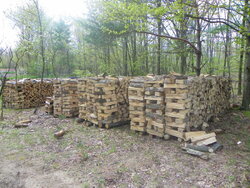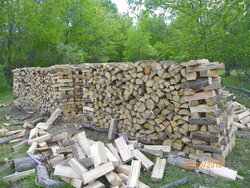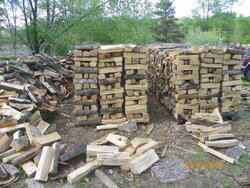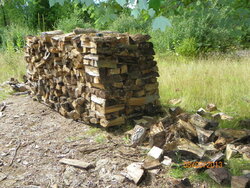Last night I started moving this winter's wood up to the house. I started with hickory that was c/s/s November 2011 (so almost 2 full years). The wood was very dull grey, very light, and almost felt like it would suck the moisture out of your skin....until I got to the bottom.
As I grabbed a few of the splits on the bottom the first thing I noticed was clean crisp color of the split and then how heavy it was
and then how heavy it was  . Sooooo, I took an ax to it and then the moisture meter which read 23%
. Sooooo, I took an ax to it and then the moisture meter which read 23% . As I compared (yes, always trying to learn from my mistakes) the way I stacked the bottom compared to the top I found that these logs were very tight which meant no airflow. Ended up being about six splits that went onto next years stacks so not too bad.
. As I compared (yes, always trying to learn from my mistakes) the way I stacked the bottom compared to the top I found that these logs were very tight which meant no airflow. Ended up being about six splits that went onto next years stacks so not too bad.
Lesson learned, airflow=dry.
fv
As I grabbed a few of the splits on the bottom the first thing I noticed was clean crisp color of the split
 and then how heavy it was
and then how heavy it was  . Sooooo, I took an ax to it and then the moisture meter which read 23%
. Sooooo, I took an ax to it and then the moisture meter which read 23% . As I compared (yes, always trying to learn from my mistakes) the way I stacked the bottom compared to the top I found that these logs were very tight which meant no airflow. Ended up being about six splits that went onto next years stacks so not too bad.
. As I compared (yes, always trying to learn from my mistakes) the way I stacked the bottom compared to the top I found that these logs were very tight which meant no airflow. Ended up being about six splits that went onto next years stacks so not too bad.Lesson learned, airflow=dry.
fv






